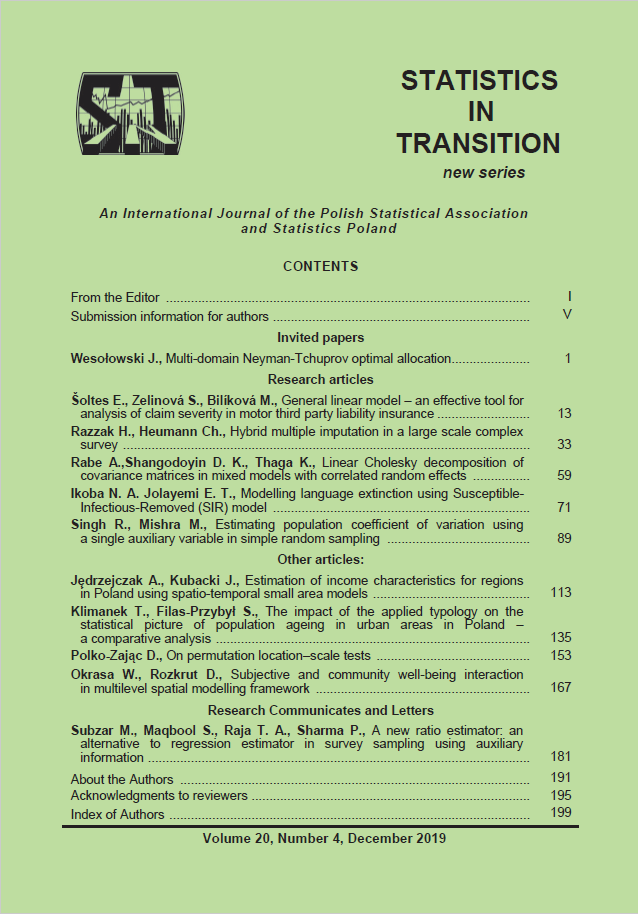ARTICLE
ABSTRACT
Modelling the covariance matrix in linear mixed models provides an additional advantage in making inference about subject-specific effects, particularly in the analysis of repeated measurement data, where time-ordering of the responses induces significant correlation. Some difficulties encountered in these modelling procedures include high dimensionality and statistical interpretability of parameters, positive definiteness constraint and violation of model assumptions. One key assumption in linear mixed models is that random errors and random effects are independent, and its violation leads to biased and inefficient parameter estimates. To minimize these drawbacks, we developed a procedure that accounts for correlations induced by violation of this key assumption. In recent literature, variants of Cholesky decomposition were employed to circumvent the positive definiteness constraint, with parsimony achieved by joint modelling of mean and covariance parameters using covariates. In this article, we developed a linear Cholesky decomposition of the random effects covariance matrix, providing a framework for inference that accounts for correlations induced by covariate(s) shared by both fixed and random effects design matrices, a circumstance leading to lack of independence between random errors and random effects. The proposed decomposition is particularly useful in parameter estimation using the maximum likelihood and restricted/residual maximum likelihood procedures.
KEYWORDS
correlated random effects, covariance matrix, linear Cholesky decomposition, linear mixed models
REFERENCES
CARLSON, D. H., DATTA, B. N., (1979). The Lyapunov matrix equation SA+A*S = S*B*BS. Linear Algebra and Its Applications, 28, pp. 43–52.
CHEN, Z., DUNSON, D. B., (2003). Random effects selection in linear mixed models. Biometrics, 59, pp. 762–769.
DANIELS, M. J., ZHAO, Y. D., (2003). Modeling the random effects covariance matrix in longitudinal data. Statistics in Medicine, 22(10), pp. 1631–1647.
DE HOOG, F. R., ANDERSSEN, R. S., LUKAS, M. A., (2011). Differentiation of matrix functions using triangular factorization. Mathematics of Computation, 80(275), pp. 1585–1600.
GARCIA, T. P., KOHLI, P., POURAHMADI, M., (2012). Regressogram and meancovariance models for incomplete longitudinal data, Journal of the American Statistical Association, 66(2), pp. 85–91.
GASKINS, J. T., DANIELS, M. J., (2013). A nonparametric prior for simultaneous covariance estimation, Biometrika, 100(1), pp. 125–138.
GELFAND, A. E., SAHU, S. K., CARLIN, B. P., (1995). Efficient parameterization for normal linear mixed models, Biometrika, 82(3), pp. 479–488.
HAN, E-J., LEE, K., (2016). Dynamic linear mixed models with ARMA covariance matrix, Communications for Statistical Applications and Methods, 23(6), pp. 575–585.
HOLAN, S., SPINKA, C., (2007). Maximum likelihood estimation for joint meancovariance models for unbalanced repeated measures data, Statistics and Probability letters, 77, pp. 319–328.
LAIRD, N. M., WARE, J. H., (1982). Random-effects models for longitudinal data, Biometrics, 38(4), pp. 963–974.
LANGE, N., RYAN, L., (1989). Assessing normality of random effects models, Annals of Statistics, 17, pp. 624–642.
LEE, K., BAEK C., DANIELS, M. J., (2017). ARMA Cholesky factor models for the covariance matrix of linear models, Computational Statistics and Data Analysis, 115, pp. 267–280. LI, E.,
POURAHMADI, M., (2013). An alternative REML estimation of covariance matrices in linear mixed models, Statistics and Probability Letters, 83, pp. 1071–1077.
PAN, J-X., MACKENZIE, G., (2003). On modeling mean-covariance structures in longitudinal studies, Biometrika, 90(1), pp. 239–244.
PAN, J-X., MACKENZIE, G., (2006). Regression models for covariance structures in longitudinal studies, Statistical Modeling, 6, pp. 43–57.
PINHEIRO, J. C., BATES, D. M., (1996). Unconstrained parameterizations for variance-covariance matrices, Statistics and Computing, 6, pp. 289–296.
PINHEIRO, J. C., BATES, D. M., (2000). Mixed-effects models in S and S-Plus, Springer-Verlag, New York, pp. 205–207.
POURAHMADI, M., (1999). Joint mean-covariance models with application to longitudinal data: Unconstrained parameterization, Biometrika, 86(3), pp. 677– 690.
POURAHMADI, M., (2000). Maximum likelihood estimation of generalized linear models for multivariate normal covariance matrix, Biometrika, 87(2), pp. 425– 435.
STEWART, G.W., (1998). Matrix algorithms volume I: Basic decompositions, SIAM Publications, Philadelphia, U.S.A., p. 183.
ZHANG, W., LENG, C., (2012). A moving average Cholesky factor model in covariance modelling for longitudinal data, Biometrika, 99(1), pp. 141–150.
ZIMMERMANN, D. L., VINCENT, N-A., HAMMOU, E., (1998). Computational aspects of likelihood-based estimation of first order antedependence models, Journal of Statistical Computation and Simulation, 60(1), pp. 67–84.
